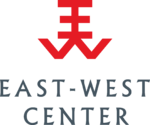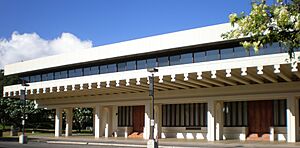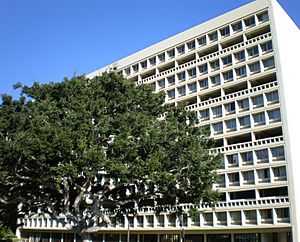East–West Center facts for kids
The East–West Center (EWC) is a special organization. It was created by the U.S. Congress in 1960. Its main goal is to help people and countries in Asia, the Pacific, and the United States understand each other better. It does this through education and research.
Suzanne Vares-Lum is the current president and chief executive of the East-West Center. Its main office is in Honolulu, Hawaii, at the University of Hawaiʻi at Mānoa.
Contents
A Look Back: The East-West Center's Story
The East-West Center was started to help the United States and its allies work together. It aimed to do this by sharing knowledge and ideas. In its early days, the Center focused on students from countries that were friendly with the U.S.
The idea for the Center came from a professor named Murray Turnbull in 1959. He suggested creating an "International College of Cultural Affairs." At first, the University of Hawaii didn't have enough money for the idea.
But then, Senator Lyndon B. Johnson spoke about creating an international university in Hawaii. He wanted it to be a place where smart people from the East and West could meet. This made the University of Hawaii interested again, especially with the chance of getting money from the government.
In 1959, Senator Johnson and Delegate John A. Burns introduced bills to create this center. President Dwight D. Eisenhower signed a law in 1960 that allowed the East-West Center to be created. He also approved money for new buildings.
The University of Hawaii officially agreed to run the East-West Center in October 1960. They received their first money from the government soon after.
Over the years, there were discussions about how the Center should be managed. Some people in the government wanted more control over who was admitted.
In 1961, Vice President Lyndon Johnson attended the groundbreaking ceremony for the Center's first buildings. Famous architect I. M. Pei designed five of these buildings. They were built on a new campus area near the university.
Many important buildings opened in 1962 and 1963:
- Edmondson Hall: A building with classrooms and labs.
- Kennedy Theatre: A large theater for performances.
- Hale Kuahine: A dormitory for female students.
- Lincoln Hall: A place for visiting scholars and professors to live.
- Jefferson Hall: A building for conferences, a cafeteria, and offices.
- Hale Manoa: A tall dormitory for male students.
A beautiful Japanese garden called "Seien" was a gift from Japanese business leaders in 1963. It includes a Japanese tea house given by the Urasenke Foundation in 1972. In 1967, the Thai Pavilion was assembled. It was a gift from the King and Queen of Thailand.
In 1968, a former East-West Center student faced legal trouble in Taiwan. This led to student protests at the University of Hawaii and the East-West Center. The student was later released.
In 1969, another building, Moore Hall, was built with federal funds for the Center. In 1970, students at the East-West Center spoke out about world events. They wanted the Center's actions to match its goals of promoting understanding.
In 1977, John A. Burns Hall was completed. This building holds administrative offices. It was built by the State of Hawaii to help pay back the federal government for using some of the buildings that were originally funded for the East-West Center.
How the East-West Center Works
The East-West Center has several important parts:
- Education programs
- Research programs
- Seminars and workshops
- An office in Washington, D.C.
- An Office of External Affairs
- The East–West Center Foundation
Leaders of the Center
Murray Turnbull, an art professor, was the first interim director. Then, Alexander Spoehr, an anthropologist, became the first chancellor in 1961. Other leaders followed, including Thomas H. Hamilton and diplomat Howard P. Jones.
In 2021, Major General Suzanne Vares-Lum became the president of the East-West Center. She is the first woman and the first Native Hawaiian to lead the organization.
Research Programs
The Research Program studies many important topics. These include:
- How countries grow their economies
- Trade between nations
- Energy and resources
- How governments work
- Safety and peace
- Population and health
- The environment
A key part of the Research Program is the Pacific Islands Development Program. This program helps 22 Pacific island nations with research and training.
Education Programs
The Education Program offers chances for students to learn and grow. It also provides training for teachers from the U.S. and the Asia-Pacific region.
- Student Program: This program works with the University of Hawaii and other universities. It gives scholarships to students from around the world.
- Asia Pacific Leadership Program (APLP): This program helps graduate students and professionals become better leaders.
- AsiaPacificEd and Asian Studies Development Program: These programs help teachers add more about Asia and the Pacific into their lessons.
- Education 2020: This focuses on new ways to solve education problems in the Asia-Pacific region.
Many students in these programs live in East-West Center dormitories, like Hale Manoa Dormitory.
East–West Seminars
East-West Seminars bring together different kinds of professionals. These include people from government, businesses, and the media. They meet for short programs to share ideas and talk about important issues.
- Media Program: Helps journalists learn about issues in the region and the U.S.
- Senior Policy Seminar: Brings together top officials and leaders to discuss key regional topics.
- Asia Pacific Executive Forum: Organizes discussions in American cities about business and economic topics in the region.
The East-West Center also supports programs that help women grow as leaders. For example, the 2014 Changing Faces Women's Leadership Seminar helped women entrepreneurs from the Asia Pacific Region.
Office of External Affairs
The Office of External Affairs (OEA) connects the Center's work with the community. It shares research, hosts public events, and works with the media.
- News and Information office: Shares the Center's research and analysis with journalists and the public.
- Arts Program: Shows performances and exhibits that highlight the cultures and art forms of the Pacific region.
- Alumni Office: Works with a worldwide network of professionals who have been part of the East-West Center.
The Hawaii International Film Festival started in 1981 as a project of the East-West Center. It focused on academic discussions and showed films from many countries. Even though the festival became independent in 1994, it still aims to highlight Asian and Indigenous voices in film.
East–West Center Foundation
The East-West Center Foundation helps the Center get more support. It raises money from private groups, individuals, and companies. This money helps fund scholarships, research, and seminars that are not covered by government funding.
How the Center is Funded
About half of the Center's money comes from the U.S. government. Other support comes from private groups, individuals, foundations, companies, and governments in the region. For example, in 2005, the Center received $37 million in total.
In recent years, there have been changes in funding requests from U.S. presidents. Sometimes, the requested budget was lower, but the final amount received often changed. Recently, with more focus on climate and global issues, the Center has seen its federal funding increase again.
East–West Center Gallery
The East-West Center Gallery shows different art exhibits. These exhibits feature traditional and modern art from the Pacific region. The gallery is on the University of Hawaii campus and is open every day except Saturday. They also host cultural performances.
Hale Manoa Dormitory
Hale Manoa is the East-West Center's student dormitory. This tall, 13-story building was built in 1962 and designed by architect I. M. Pei. It is located at the University of Hawaiʻi in Honolulu.
The dormitory can house over 400 students. Most residents are graduate students who have scholarships from the East-West Center or are part of its programs. This includes students from programs like the EWC Graduate Degree Fellows and the Asia Pacific Leadership Program. Many residents are international students from countries like China, Japan, Thailand, Vietnam, the Philippines, and Indonesia.
Hale Manoa used to be only for male students. Its sister dormitory, Hale Kuahine, was for female students. Both buildings were designed by I. M. Pei. Today, both Hale Manoa and Hale Kuahine are open to both male and female students.





